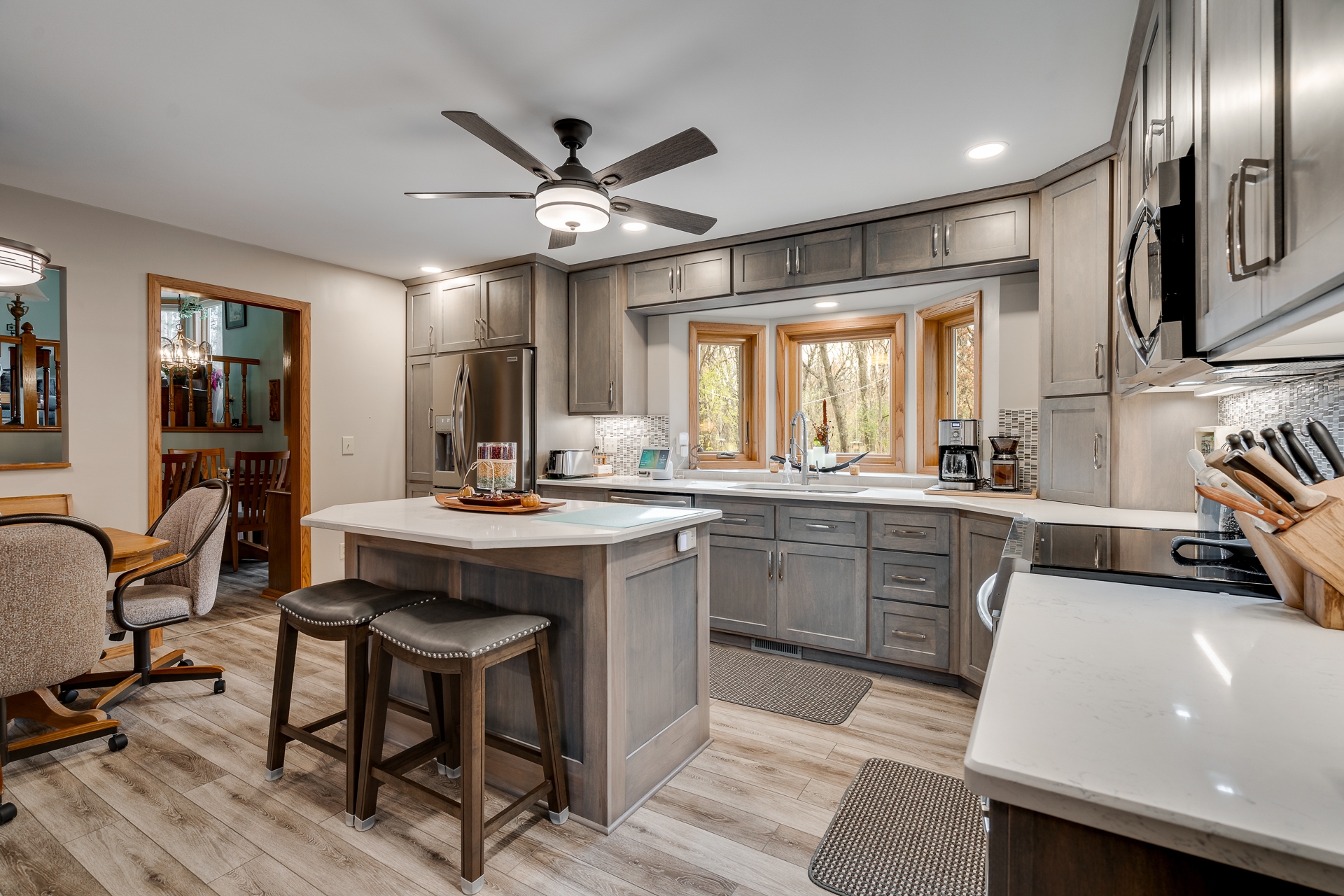Month: May 2022
8 Surefire Vegetables and Herbs for Beginning Gardeners
Learn the edible plants that are popular and easy to grow in a backyard or container garden.
For gardeners, poring over the pages of a seed catalog can be a feast for the eyes. Whether it’s heirloom crookneck squash or ‘Green Zebra’ tomatoes, the seed varieties available to home gardeners rival any farmers market. Similarly, going to a nursery and seeing row upon row of baby tomato, lettuce and kale plants can make it hard to decide where to start. What’s a backyard food grower to do?
By growing a small selection of carefully chosen crops, you will give yourself the best opportunity for success. If you’re new to gardening, it’s better to grow just five types of vegetables rather than 15. Over time, you’ll learn which crops and varieties work best for your microclimate, taste and lifestyle.
Here are some of the best vegetables and herbs for gardeners of all types, including beginners. In addition to being easy to grow and productive, many of these crops are well-suited to growing in small spaces.
Start with your favorite vegetables that you regularly buy from the grocery store. If you’re a big fan of kale salads, be sure to plant kale. Radishes are very easy to grow and look gorgeous, but if you’re not a fan of eating them, don’t grow them.
Sweet potatoes and peanuts are popular crops in the American South, but they rarely succeed in northern climates. However, tender greens like spinach thrive in cool environments. To find vegetables that suit your growing region, look for local seed companies, check out what’s being grown in farmers markets and ask neighbors what they’re growing. Find out your area’s average first and last frost dates; these will provide an essential guideline for when to plant seeds.
Your garden space will also inform what you can grow. If your space is small, choose plants with a small footprint. Zucchini can grow in a large container, but their huge, sprawling leaves may take up the better part of a balcony garden.
1. Snap Peas

Few things in life rival the flavor of a fresh snap pea right off the vine. Because the sugars in this crop degrade quickly, snap peas truly taste better when grown at home. With their vertical growth, peas don’t take up much room — just be sure to set up a trellis and train them rigorously, as the vines can get unruly. Peas are a cool-season crop and are planted directly into the soil as seeds in late winter or early spring in most areas.
Tip: Use a pea inoculant (a powder that acts like a probiotic for peas and beans) at the time of planting to ensure success. Look for varieties that are resistant to pea enation mosaic virus and powdery mildew.
When to plant: Sow seeds about four to six weeks before the average last frost date in spring. In mild-winter climates, peas can also be planted in the fall; sow seeds two to three months before the first expected frost date.
Light requirement: Full sun to partial shade; provide afternoon shade in hot climates.
2. Radishes

Cheery, colorful radishes are some of the first vegetables gardeners can harvest in the spring. This attractive cool-season plant grows quickly and takes up little room, making it an ideal choice for small-space gardeners. Don’t know what to do with radishes? For a classic French dish, slice them raw (wash and scrub well to remove soil) and serve with salt and butter. The leaves are also edible and can make a good substitute for cooked spinach.
When to plant: Sow seeds two to three weeks before the average last frost date in spring, and in late summer four to six weeks before the average first fall frost. Continue sowing seeds every two weeks in both spring and fall.
Light requirement: Full sun to partial shade
3. Mint

Want your own supply of peppermint tea? It’s as easy as growing a peppermint plant. This perennial herb grows so vigorously that it should always be planted in containers — otherwise, it may take over your entire garden. Keep your mint tidy with regular trimming, or allow it to go to flower and attract tons of bees. This hard-to-kill plant is a great choice for apartment gardeners.
When to plant: Purchase seedlings from a garden supply store, or ask a friend to dig up a section of his or her plant. Plant seedlings in early spring, or in the fall in warm-winter climates.
Light requirement: Full sun to partial shade
4. Chives

Snipped chives taste delicious on eggs, pasta — just about everything. In grocery stores, they can be difficult to find and expensive, but in gardens, they’re incredibly easy to grow. This perennial herb has a long harvest season and will come back year after year if you plant it in nice rich soil. Try growing them in a large pot right outside your kitchen window. Harvest chives by simply giving them a “haircut” with kitchen scissors as needed.
When to plant: Purchase seedlings from a garden supply store, or start seeds indoors eight to ten weeks before the average last frost date. Plant seedlings in the early spring. Chives are perennials and take several years to reach their full size, so harvest lightly until your plants are well-established.
Light requirement: Full sun
5. Mesclun Mix
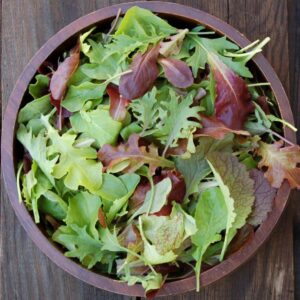
The word “mesclun” comes from the Provençal word for “mixture.” In gardening terms, mesclun is a combination of seeds that are planted together to create a ready-made baby salad featuring a variety of colors, flavors and textures. The result is similar to the packaged salad mixes you can find in grocery stores, but far more fresh and exciting. Seed catalogs often have a variety of mesclun mixes to choose from, typically featuring arugula, mustard greens and lettuce. To achieve success with mescluns, sow seeds thinly (about one seed per square half-inch). Plant some each week and harvest leaves with scissors as soon as they look ready.
When to plant: Plant a little mesclun every one to two weeks from early spring to early summer. In mild-winter climates, plant again from late summer to mid-fall. Water well and protect from hot temperatures.
Light requirement: Full sun to partial shade
6. Kale

This popular low-maintenance green is a must for many gardeners. If you’re growing kale in containers, sow seeds similarly to mesclun mixes and harvest the baby greens. In raised beds with rich soil, many varieties will grow more than 6 feet tall. Choose your kale variety according to your climate and season. ‘Lacinato’ kale, also called dinosaur kale, is a Mediterranean plant that does well in the summer or in warm environments. Curly Scotch kale and tender Siberian kale are great winter crops that can tolerate frost.
When to plant: Sow seeds in early to midsummer for fall and winter harvest. For a summer harvest, plant seeds in spring two weeks to a month before the last frost date.
Light requirement: Full sun; provide afternoon shade in very hot climates.
7. Cherry Tomatoes

Tomatoes are one of the most rewarding crops to grow in a home garden. If you’re a new gardener, start with a classic disease-resistant cherry tomato like ‘Sweet Million’. Be sure to build a trellis for the long vines, and plant them in a sunny spot where they can be protected from rain. Cherry tomatoes are an ideal choice for container gardens.
When to plant: Set out starts or nursery plants when the soil is warm and there’s no danger of frost. Start seeds indoors five to eight weeks before your planned planting date.
Light requirement: Full sun
8. Zucchini
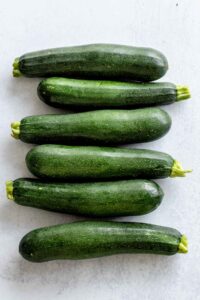
Get ready, because once your zucchini plants start producing, it’ll be hard to keep up with them. Zucchini are famous for producing more food than most people can handle. Check your plants every day or two, and harvest them as soon as they’re a little over a foot long (bigger fruits can get tough and stringy). Zucchini are great in baking and popular as a low-carb pasta substitute. Just make sure that you have enough space in your garden for this sprawling plant.
When to plant: Sow seeds about two weeks after the last frost date when soil temperatures reach 70 degrees Fahrenheit (21 degrees Celsius). You can start seeds indoors about one week before that date.
Light requirement: Full sun
10 Tricks to Help Your Bathroom Sell Your House
As with the kitchen, the bathroom is always a high priority for home buyers. Here’s how we at HomesReinvented-MN help you showcase your bathroom so it looks its best during the open house.
Buyers love the allure of a fresh, beautiful bathroom that reminds them of luxury hotels or soothing spas they have enjoyed. And, most important, buyers want to envision themselves enjoying this luxury every day in their new home.
However, the reality is that most of us do not have the perfect bathroom. And we know that, in most instances, it is not a wise investment to do a full, costly renovation just for a home sale. It simply doesn’t translate into profit.
A better strategy is to maximize what you already have, on a budget. You want to transform your real-life, everyday bathroom into a five-star hotel experience that prospective buyers will love, without overcapitalizing. Here are simple ways to create havens with a wow factor.
1. Clear off the counters to create a blank canvas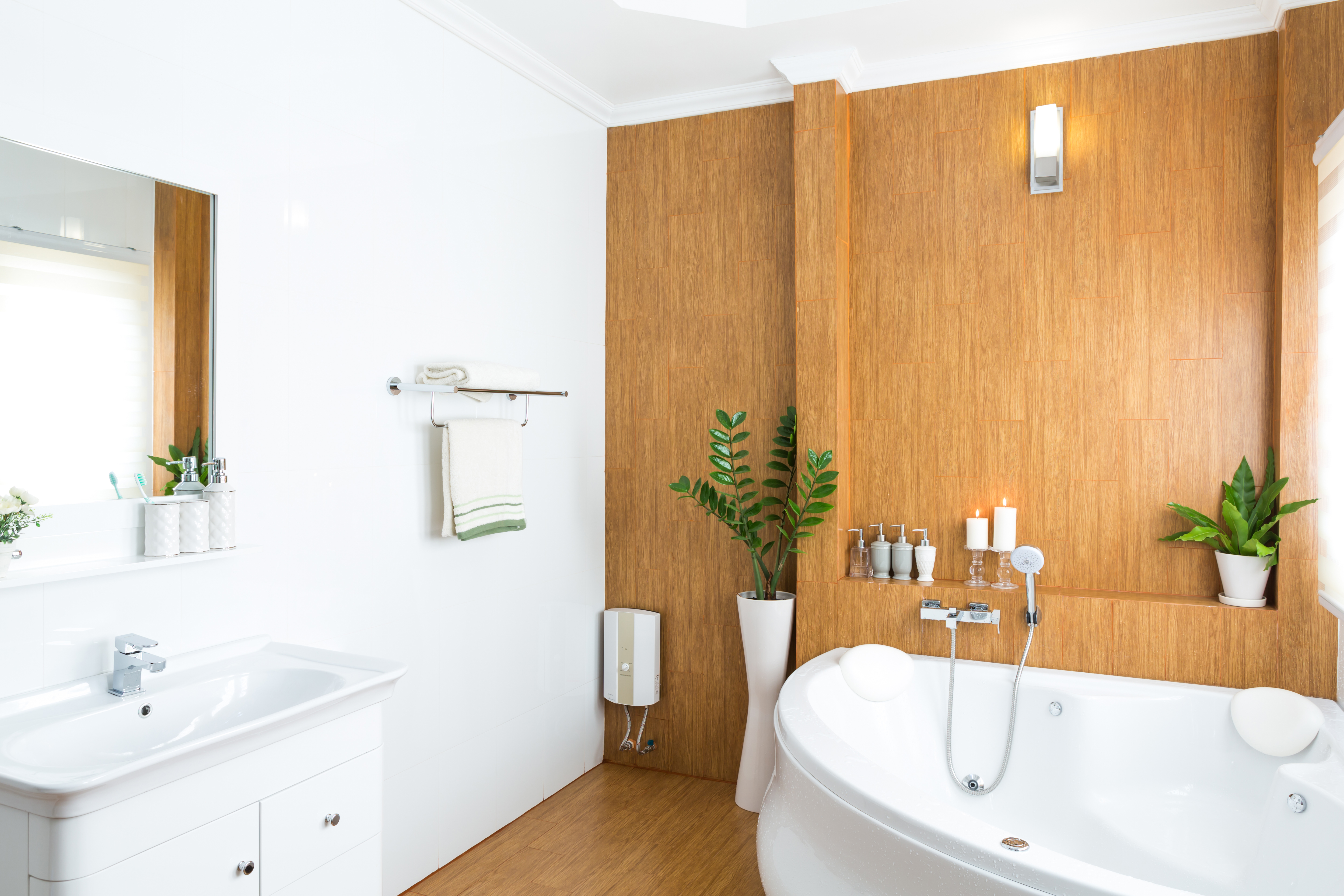
Remove all of your everyday toiletries and bathroom supplies. This includes soaps, toothbrushes, cotton balls — everything. (And don’t forget the products in the shower.) Buyers do not want to see your personal hygiene products. In fact, this can make them feel as though they are intruding on your personal space, which can be distracting and a little awkward.
2. Get rid of cleaning products
Clear the space including floors, counters, shelves and shower of anything that could remind a potential buyer of work. Toilet brushes, plungers, all purpose sprays, and extra toilet paper just remind buyers that they are in someone else’s bathroom and takes away the magic of walking into a clean, decluttered space where they hope to relax, not clean.
Tip: Remove the bathroom scale, too. Remember, your buyers want a luxurious bathroom experience, not a reminder of those extra pounds they are trying to lose.
3. Maximize your storage
Storage space sells. Your buyers will be looking inside your bathroom cupboards to see how much space they offer. Make sure they are only half to two-thirds full and well organized. Store the little things you use every day (hair elastics, lip gloss) in a pretty box or basket with a lid to avoid a tidal wave of trinkets on the shelves.
Tip: If you’re running out of space to store your toiletries, keep the overflow in simple wicker baskets. When buyers are coming to inspect your home, just grab the baskets and stash them somewhere else.
4. Make minor upgrades
Rather than spending many thousands completely renovating your bathroom, it’s much smarter to spend your money only where it will show and to make small, inexpensive upgrades that will create a large impact. As a general rule, improvements that can’t easily be seen don’t translate into a higher sale price.
The best bang-for-your-buck bathroom upgrades are: repainting the walls, replacing leaking and worn taps, updating the cabinet hardware, installing new light fittings and updating towel bars.
Note: In some bathrooms it’s also worth considering changing the tiles (large white tiles always make a bathroom feel more spacious and contemporary), replacing shower screens and investing in new cabinetry and countertops. I find this is often warranted in a higher-priced property, where buyers are looking for (and expecting) a higher level of bathroom luxury.
5. Clean thoroughly
Clean everything to within an inch of its life. No, it’s certainly not exciting, but it’s super important. Buyers will pay a premium for new, so your aim is to create a new feel. Everything must be immaculate, as this creates the impression that your home has been well maintained and well loved.
6. Hang luxurious towels
Any bathroom can be instantly transformed by adding beautiful, soft towels. New is best (once towels have been washed, they never look quite the same). So it’s a great idea to keep your new towels just for display only. Pack them away between buyer inspections and reinstate them just before the prospective buyers arrive.
Tip: If there is a lot of extra counter space, you can also place a neatly folded pile of two or three matching towels on the vanity or side of the bath for extra luxury. Thick, white, luxurious towels always work well, and there are some beautiful textured options. Funky, brightly colored towels are popular at the moment too; for a more dramatic effect, you could consider adding a splash of bold color.
7. Stick with neutrals
If you are going to repaint your walls, upgrade your tiles or invest in new cabinetry, it’s always a good idea to keep to a neutral palette for these larger elements, as it will appeal to more buyers. If you want to add some fresh color, use towels and accessories.
8. Beautify with accessories
Now that you have cleared away your personal bathroom products, bring in a few well-chosen accessories to add a layer of warmth, elegance and luxury. Think about creating a spa-like experience with accessories in tranquil, soft colors. Include fragrant soaps, bath oils, natural loofahs and candles.
It’s important to display these products as groupings rather than scattering them around the room; scattered products can look like clutter. Less is better. Think simplicity. You may want to consider using a wooden tray as a base and group items together in odd numbers. Vary the height of candles and jars, too.
“Fix It or Not?” – What to Know When Prepping Your Home for Sale
Being a Real Estate agent with NRG, many of the homeowners I am working with ask me whether a repair is worth making before their house officially goes live on the MLS, once they’re under contract.
When you make the decision to sell your home, it can be tricky to know which changes would make your home sell more quickly or boost the sale price — and which would be a waste of your time and resources. Satin Touch is not only a licensed general contract but also has a licensed Realtor, meaning we know the true cost to “Fix It or Not”. This gives my clients an advantage when it comes to selling and/or buying.
Each home (and each homeowner) is different; that’s why we’ve come up with eight key questions to ask yourself before making any changes to prep your home for sale.
General Questions
If you’re not using HomesReinvented-MN to sell your home and are looking to do a ‘Sell by Owner’ or already have a trusted Real Estate Agent in mind, these first three questions will help you take the temperature of the real estate market in your area and assess the competition.
1. How hot or cold is the market in your area?
Are homes being snapped up after the first open house, or are they languishing on the market for months? Are homes being sold at or near the asking price, or for much lower? Are open houses bustling with people, or is attendance sparse? Get a feel for the market in your area by talking with your real estate agent and checking local listings. If it’s a seller’s market, you may be able to get away with doing fewer repairs and modifications before selling, and still have good results — in a buyer’s market, expect to do more work to make a positive impression on buyers.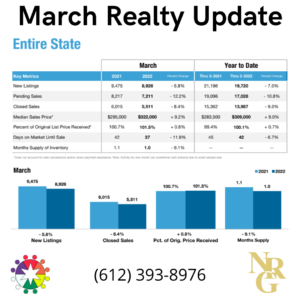
2. How fast are you looking to sell?
If you need to sell your home immediately — say, because you have already committed to buying another home or need to move because of work — it is in your best interest to do everything in your power to ensure a quick sale at the highest price possible. If you have more flexibility, and you feel uncomfortable making too many pricey changes to your home before selling, it may make more sense to focus on cleaning, decluttering and making small cosmetic changes (like painting) — particularly if the market is hot and favors the seller. If you aren’t getting the offers you would like, you can always decide to spring for a few bigger changes later and relist your home.
3. What is the condition of comparable homes on the market?
It can be quite helpful to know a little about the homes that buyers in your area are looking at. Examine photos of homes for sale in your area or even attend a few open houses, and make a mental note of how the other homes compare to yours. Are the kitchens updated? Are the floors in good shape? If all of the other homes you see have a certain feature (for instance, an updated kitchen) that yours lacks, consider making that a priority. You don’t need to make your home exactly like all the other homes on the market; just make sure there isn’t a single factor that could give your home a disadvantage.
The next five questions will help you assess whether or not to make a specific repair or change before selling your home.
4. Does the faulty item give the impression the property has not been well cared for?

Leaky faucets, cracked tiles, an overgrown lawn, broken appliances or anything else that doesn’t work as it should can immediately turn off buyers. At an open house, people often zip through quite quickly, and if they notice one or two things that send up red flags, they may not give your home another chance.
5. Can you find a less expensive fix?
Let’s say you scoped out the comparable homes on the market in your neighborhood, and they all have updated kitchens but yours hasn’t been touched for some time. Rather than spend big on a full kitchen remodel, why not give your kitchen a less costly refresh? For instance, you could paint the cabinets, swap out cabinet hardware, change the light fixtures and upgrade the appliances to something current and functional but not top-of-the-line. You will put some money into it but not nearly as much as with a full remodel — well worth it if it gets your home in the running in a competitive market.
6. How much will you realistically need to lower the price if you don’t fix it?
If you have a lot of costly repairs to tackle to get your home ready to sell, you may be considering selling it as is. But keep in mind that buyers looking for a fixer-upper will also be looking to discount the selling price for the repairs plus the hassle. In other words, you won’t be able to simply estimate how much the repairs will cost and deduct that from the selling price; you’ll need to deduct even more to make it worth the buyer’s time and effort. Whether you choose HomesReinvented-MN to list your home or not, discuss this with an industry professional and look into other fixer-uppers for sale in your area to come up with an appropriate selling price.
7. Is it one of the first things potential buyers will see?
First impressions are key, and that is never more true than in the real estate business! If you have a repair you are unsure about tackling, use this as a litmus test: Is it something the buyer will see as he or she approaches your house and walks through the front door? If so, fix it.
8. Could it be a deal breaker?

Some home repairs, like a new roof, are just so major that they will scare off all but the most determined buyers. If the market in your area is hot (see No. 1) and you have ample time (see No. 2),
there’s no harm in trying to sell without making the big repair, as long as you are willing to price it accordingly (see No. 6). If it’s a buyer’s market but you don’t have time to make the repair before
listing, you could offer to pay for it as part of the sales agreement — otherwise it’s probably best to make the change first and then put your home on the market.
Are you or a friend/family thinking about selling? For home analysis and a professional recommendation to “Fix It or Not”, call HomesReinvented-MN today (612) 393-8976
Top Takeaways From A Recent Kitchen Trends Study
Storage is a major focus, the open-concept floor plan is losing steam, and project scope is scaling back.
As people spend more time in them, homeowners remodeling their kitchens are transforming these spaces for the way we live now, according to new research from Houzz. That includes upgrading cabinetry to create the right storage. Homeowners also are less likely to turn their kitchens into open-concept spaces (where the kitchen is open to other spaces). And they’re seeking a connection in their renovated kitchens to the outdoors.
Kitchen Storage Is a Major Focus
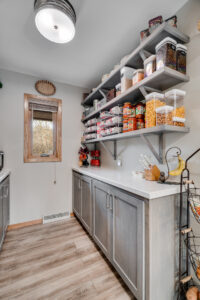
Nearly all homeowners (94%) renovating their kitchens improve the cabinetry in some way, according to the report. Most (63%) are replacing the cabinets entirely, while 1 in 3 opts for a partial cabinet upgrade.
“Storage has really come into focus as people have spent more time at home during the pandemic,” says Liza Hausman. “We’re seeing an increase in the amount of cabinetry added in renovations”. And, as homeowners reach out to HomesReinvented by SatinTouch for help making their kitchens work better, we find our clients have the same storage concerns, or the lack there of.
Of the 31% of renovating homeowners choosing partial cabinet upgrades, 28% add at least some new cabinetry to the renovated kitchen — nearly four times as many as in the previous year. Others opting to partially upgrade their cabinets are refinishing the exteriors or replacing doors only.
The share of renovating homeowners adding or upgrading a pantry space also increased, with 46% upgrading their pantry cabinets, up 3 percentage points from the prior year. The share of renovating homeowners adding a walk-in pantry grew to 13%, up from 10% the year before.
Open-Concept Kitchens Lose Appeal — Except When They Open to the Outdoors
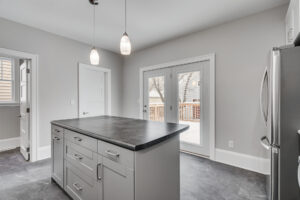
The share of renovating homeowners opening their kitchens to create open-concept floor plans (43%) dropped significantly this year compared with two years ago (53%). Many people have experienced the downsides of this setup while they’ve been home during the pandemic, often with two partners working at home as kids attend virtual school from home.
While a smaller share of remodeling homeowners want their kitchens to be open to other indoor spaces, more than 1 in 5 are choosing to open their kitchens to the outdoors. That’s consistent with a steady trend they’ve seen on Houzz of increased demand for outdoor home professionals.
Neutral Kitchen Palettes Reign
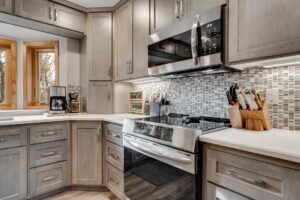
Renovating homeowners are continuing to seek out neutral tones for their remodeled spaces. The top colors for upgraded cabinets in renovated kitchens are white (41%), medium wood tones (13%) and gray (10%). Neutrals are also trending for kitchen walls, with gray (28%), white (26%) and beige (21%) the top picks.
Still, some homeowners are introducing more colorful alternatives to their kitchen walls, like blue (7%) or green (4%). Some are bringing color in through backsplashes or appliances. White may be the top backsplash color pick (37%), but nearly 1 in 5 of those upgrading their backsplashes chooses a multicolored option. And 1 in 10 upgrading appliances chooses black stainless steel, while another 6% are selecting black appliances in another material.
Kitchen Islands Stand Out

While neutrals are popular for wall cabinetry, many renovating homeowners (41%) are choosing contrasting colors for their kitchen island cabinets. Blue (27%) and gray (20%) are the top contrasting color picks among those who choose a contrasting island color, whereas just 13% are choosing these colors for their main cabinetry.
Median Spend Is Flat as Remodeling Scope Decreases
A large share of renovating homeowners are upgrading major kitchen features like countertops (88%), backsplashes (83%) and sinks (80%) during their kitchen remodels. That said, for the third year in a row, homeowners are scaling back project scope. For instance, a smaller share of homeowners are upgrading their light fixtures (74%) and appliances (51%) compared with the previous year (79% and 56%, respectively).
Meanwhile, the median spend on major kitchen remodels — those in which all the cabinets and appliances are replaced — completed in mid-2021 stayed steady from the previous year at $50,000. This number reflects all project types, both with and without professional help.
The median refers to the midpoint spending level nationally, self-reported by homeowners. Because it is the midpoint, it indicates that half of renovating homeowners spent more, while half spent less.


